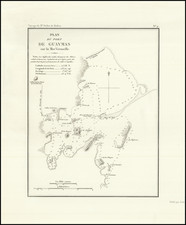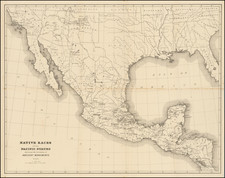An original watercolor by Captain William H. Shippard after a page from the Codex Selden.
The Codex Selden, also known as the Codex Añute, is a Mixtec manuscript that provides a detailed genealogical account of the Jaltepec dynasty spanning from the 10th to the 16th century. Despite its post-conquest creation, it is usually recognized as one of the six surviving pre-Hispanic Mixtec codices, marking a crucial source for understanding the Mixtec culture and history prior to Spanish influence. The manuscript highlights a significant historical period, with its last recorded date being 1556, suggesting its completion around this time. Originally part of John Selden's collection, a notable English jurist, the Codex Selden was bequeathed to the University of Oxford upon his death in 1654 and is presently housed in the Bodleian Library. Its existence as a possible fragment of a larger, improperly stored document adds to its historical intrigue and value, offering insights into the rich cultural and genealogical heritage of the Mixtec people.
William Henry Shippard's Mexican Paintings
William H. Shippard (1803-1865) was a pioneering 19th-century British museologist - an unsung progenitor of modern-day museum anthropology. While he is chiefly remembered as a friend of George Catlin, Shippard's profound interest in the ancient civilizations of Mexico connects him with a cohort of British contemporaries that include Lord Kingsborough and the showman William Bullock. Shippard's fascination with Mesoamerica propelled him to amass a significant collection of visual material derived from Aztec codices which he copied himself. A figure of some intrigue and scholarly ambition, Shippard endeavored to establish the Museum of Mankind in London, which seems to have evolved from his deep interest in early Mexican cultures. Although the museum did not come to fruition, Shippard's original artwork, mainly pen and ink drawings enriched with vibrant hand coloring, based on Mexican codices held in European libraries and collections, remains a valuable historical source, particularly for understanding the allure of Mexican antiquity within early 19th-century British collecting circles.
Capt. William H. Shippard, a friend of George Catlin and an avid watercolorist and museologist, was also a pioneering British Mesoamericanist. Shippard appears in British newspaper notices from the 1840s as a London-based lecturer who spoke about Native Americans and Mexican antiquities. We know he was a friend of George Catlin, and that he was involved in attempts to organize early London museum exhibitions of Mexican antiquities. In the latter efforts Shippard would seem to coincide with a group of like minded prominent English collectors interested in Mexican topics active during the 1820s and 1830s, including Lord Kingsborough and the bibliomaniac Sir Thomas Phillipps, among others. He seems to have been an armchair anthropologist and would-be museum founder, whose ambitious ideas for a London-based museum never got off the ground - at least not beyond the prospectus-printing stage. Certain aspects of Shippard's career are akin to William Bullock, the showman and connoisseur of Mexican antiquities who actually did travel to Mexico. Bullock published a notable book about his Mexican travels, and achieved a level of recognition in his day as the empresario of London's Egyptian Hall, wherein he thrilled large London audiences with his elaborate exhibitions of exotica, including Mexican items.










![[Manuscript Map of Land Dispute in Veracruz]](https://storage.googleapis.com/raremaps/img/small/55847.jpg)
![Dacota-Krieger. Guerrier Dacota [Dakota Warrior, Wahk-Tä-Ge-Li, or Big Soldier]](https://storage.googleapis.com/raremaps/img/small/81195.jpg)
![[ The Marks of Sundry of the Chief Men of Virginia ] Aliquot Heroum Virginiae Notae.](https://storage.googleapis.com/raremaps/img/small/98859.jpg)

![[Original photograph:] Native American group image, possibly in Indian Territory, with White Settlers](https://storage.googleapis.com/raremaps/img/small/82871.jpg)